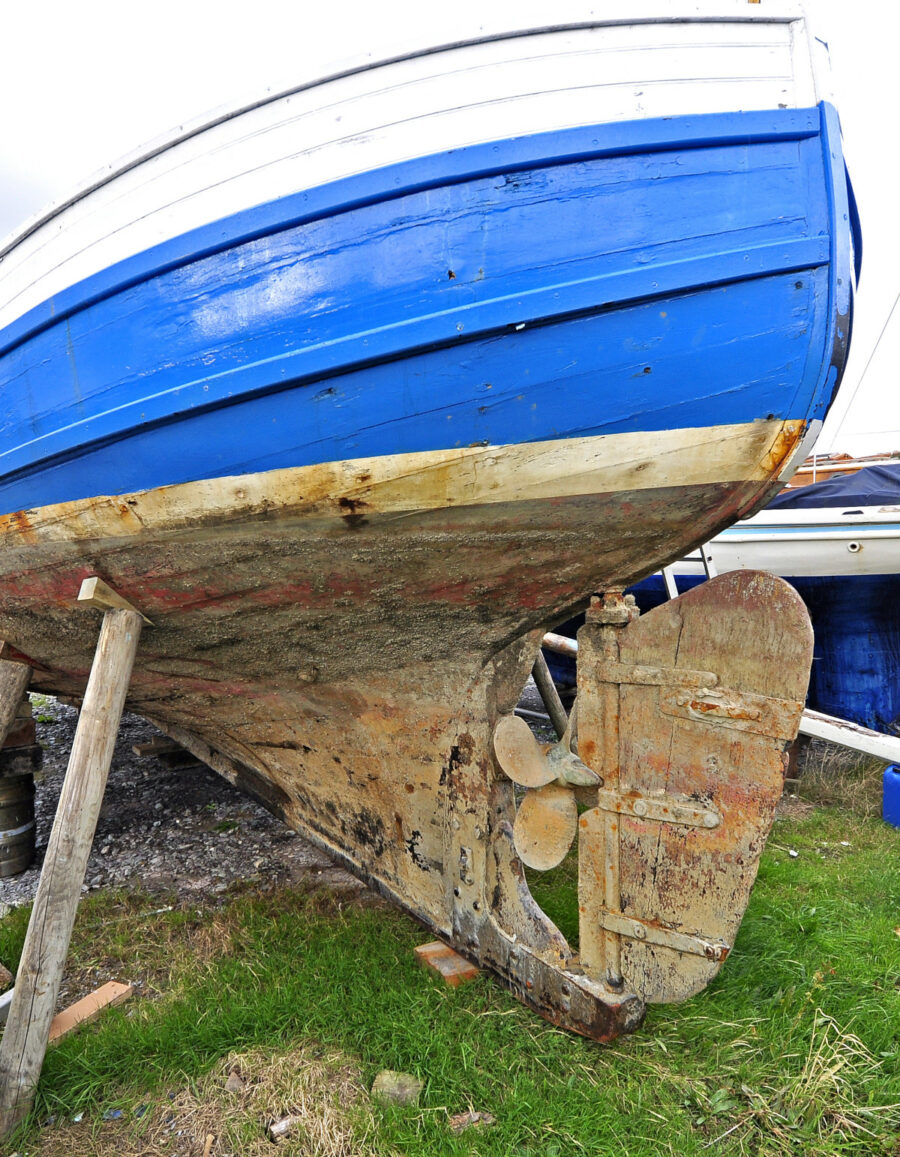Jim Mckerracher has a thing about Tommy Summers yawls. John Worrall reports
He’s restored two, worked on a third, and now has his fourth. And this could be the most challenging of the lot.
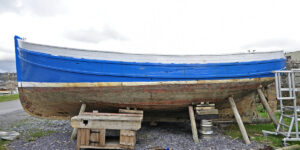
You can tell by the line …
Not a shipwright by trade, Jim Mckerracher spent much of his working life fishing, long-lining and potting around the Hebrides out of Stornoway, where he comes from. These days, he lives in North Wales and dips in and out of retirement, restoring a farmhouse, restoring old boats at Port Penrhyn, Bangor, and occasionally driving heavy plant on road projects, which is what the rest of his working life has been about, and which now helps to fund the restorations.

… and the stern – where all the basics seem to be still in place…
It’s wooden fishing boats – Fraserburgh yawls in particular – that really have his heart, those built in the mid-20th century by a handful of yards in that corner of Aberdeenshire: James Noble, Wilson Noble and J&G Forbes – but, most of all, Summers & Co. And he’s not alone in that, because their lines, strength and durability have always had a following, although in recent times, it’s the Summers boats that have accumulated the most focused and devoted fan-base.
“I like the history and craftsmanship,” says Jim. “They were the type that, I suppose, would have been the ideal boat to have had in the 1960s where I grew up. If I’d had the opportunity, I’d have loved to have been involved in boatbuilding, but there weren’t opportunities in our part of the world at the time. But we were, at least, lucky enough to be around the guys who cared for the boats then, and had to keep them fishing; to see what type of wood they used, what they did with it and, most importantly, what they didn’t do.”
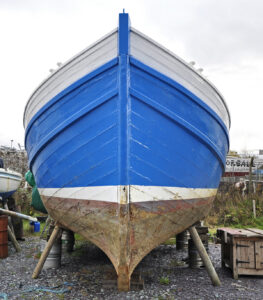
… it’s a Summers alright.
And yet, the Summers & Co yard operated for barely a decade and a half.
The company was established in 1948 as a partnership of three Fraserburgh men – Tommy Summers, Bill Duthie and George McLeman – who had all been apprentices at the James Noble yard. From then until the early 1960s, when the industry was moving away from wooden boats, they built close to 90 boats, ranging from yawls of 32-36ft, up to 80-footers.
And among that devoted fan-base, it’s the yawls that provoke the deepest emotions, their size making maintenance and repair relatively manageable, and thus granting longevity. Summers is known to have built at least 32 – others may yet be identified – and a dozen of them are still fishing, including one that Jim restored.
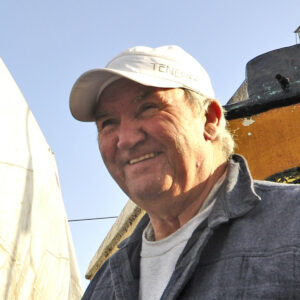
Jim McKerracher.
His first Summers restoration, back in the 1990s, the 33ft 6in 1950-built Just Reward, was lost off Ireland, but he then did the 33ft Venture, which had previously been the Girl Avril, and was built in 1958 as the Ocean Swell. He fished her himself for a while on the west coast of Scotland, but then she was sold, and is now Blyth-registered and fishing from the northeast of England.
Jim was working on his third Summers boat until this year – a boat which he originally thought was the 1956-built Graceful Morn (Fishing News, 1 March, 2018). It is part of the fascination of mid-20th-century wooden Fraserburgh boats that while their build and durability has made them last, there is no central record of their careers, including re-registrations and re-namings.
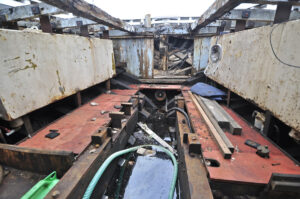
But with plenty of tlc – drop Gardner in there, do the woodwork and she’ll be right as rain. Because she is after all a Summers!
That means that some boats which have disappeared off the register may still be out there somewhere, and when a boat with the stamp of a Fraserburgh yawl is discovered – and those from all four Fraserburgh and Sandhaven yards have a certain stamp about them, unsurprisingly when most builders were apprenticed locally – some detective work is sometimes needed to establish which one it might be.
But such is the accumulating interest in Summers boats in particular that the necessary detective work is now being done, most notably by Alexander West and Malcolm Burge, who are members of the Facebook page ‘Wooden Boats Built By Tommy Summers Fraserburgh’, set up in 2017 by Shetland mussel farmer and Summers aficionado Lindsay Laurenson.
Between them, they have gradually been drawing together whatever can be found on individual boats, and the type generally.
They initially thought that Jim’s Graceful Morn was more likely to be the 1957-built Be In Time, until Alexander discovered more photographs which, along with some cross-referencing of the register, showed that she was actually the 1956-built Sceptre.
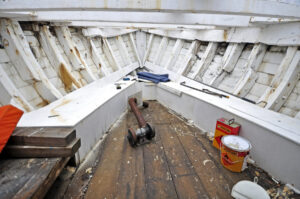
Doesn’t look too bad up forrard…
Either way, Jim was well advanced with her this summer when he had his head turned, as he himself now puts it, by a phone call which told him there was another Summers boat floating and available in a muddy creek at Gosport. She was the 32ft Morning Star, which had previously been Thalassa, but was built in 1962 as Speedwell. Even before he saw her,
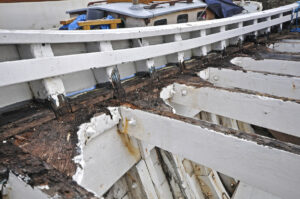
… though she’s a bit ropey around the margins.
his picking-up-survivors instinct kicked in. There was anyway a small emotional attachment to that particular boat.
“She’d been owned by an acquaintance of mine, a fine guy called Willie McKinnen, working out of Kyleakin up in the Sound of Raasay. Willie acquired her, I think in 1979, and it was he who renamed her Morning Star. He was a member of the fishermen’s association I was in, and it was with his memory in mind that I was interested straight away. I knew she’d later been sold to Shetland, where she lay for quite a while in sort of semi-fishing trim and dereliction, before she was taken on and patched up.”
Another factor for Jim at the time was the recent loss of another Summers boat, Daybreak, in Holyhead marina, just up the road on Anglesey, in March, when Storm Emma came through at a critical angle and wrecked scores of boats.
“I thought at one point that I might try to get that one back into one piece but, in the end, it wasn’t feasible. And so it seemed all the more important to preserve as many others as possible.”
He drove down to Gosport one Sunday to look at Morning Star, and crawled around inside the hull with a torch.
“There were some bad bits in the deck beams and in the upper hull planks. And the frame heads had all been cosmetically treated with odd bits of squared timber and stuff – but I thought they were fine. And she floated and wasn’t making any water – she was dry as a bone.”

But with plenty of tlc – drop Gardner in there, do the woodwork and she’ll be right as rain. Because she is after all a Summers!
And she was, after all, a Summers.
Unable to work two boat restorations at once, he moved Sceptre on to someone who was interested in completing the job, and then set about the new project, transporting Morning Star to Port Penrhyn, blocking her up on the harbourside where Sceptre had stood, and then setting about getting to know her properly. He removed the deck.
“I was stunned. It was a mad mess. There were bad knees, bad deck beams, bad carling beams, and bad parts of the hull, which I couldn’t see properly beside the wharf in Gosport. And there have been some really bad repairs, such as you don’t do in proper bona fide boat restoration. The underpart of her is okay. It’s what’s above the water. For a short while, I was thinking, ‘Do we have a fire, or what?’”
But again, she’s a Summers.
“So finally, unperturbed, I thought, ‘Go on – I’ll keep at it’. So yes, the intention is to restore her to her original look.
“I’ve got heaps of timber up at the house getting milled for deck beams, and I’ll just keep plugging away with it. I’ve taken quite a few templates off the deck beams and carling beams, and started to shape out, and that’s something that can be done inside over the winter. I’ll start on the hull first, working a plank at a time to avoid any mantraps. I have quite a lot of larch here. But I’ll also carry on with the bulldozers until the days get longer and warmer. It will anyway help to fund the purchase of a Gardner engine, identical to what was in her originally.”
And the boat will probably stay out in the open over the winter, taking the rain and snow and staying moist.
“Sceptre dried out horrendously under a plastic tent during last summer.
“The best thing, probably, will be to do the hull quickly, and then put her back in the water and work on the deck and bulwarks there.”
It won’t be a quick job, but the materials and time are to hand, and it will certainly be another labour of love. And the most important thing is that when it’s done, another example of a remarkable piece of fishing heritage will have been preserved for posterity.

